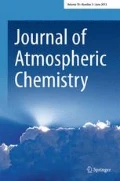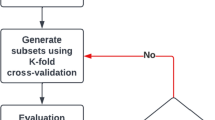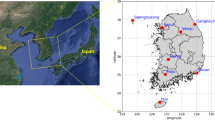Abstract
Aerosol acidity is found to exert negative effects on ecosystem diversity and architectural appearance. Current analytical technology is unable to measure in-situ aerosol acidity (i.e., pH value) of ambient fine particle due to the absence of appropriate pH electrodes. Thermodynamic modeling methods including ISORROPIA II and Extended Aerosol Inorganics Model Version IV (E-AIM V) are mostly used in the estimation of in-situ aerosol acidity with the inputs of water soluble ions worldwide. This study proposes a flexible method with the aid of multilayer perceptron (MLP) neural network analysis to estimate in-situ aerosol acidity of ambient fine particle (< 2.5 μm in aerodynamic diameter or PM2.5) with the inputs of water soluble ions (i.e., Cl−, NO3−, SO42−, Na+, NH4+, K+, Mg2+, Ca2+), gaseous air pollutants (i.e., CO, NO2, SO2) and meteorological parameters (i.e., humidity and temperature). The dataset consists of ambient fine particles collected across four individual sampling periods in the autumn and winter of 2019 and 2020 at a suburban site of Nanjing. The pH values of ambient fine particle were found to be ranging from 2.0 to 4.0 estimated by E-AIM model. Levels of pH estimated by MLP neural network analysis agreed well with pH values estimated by E-AIM model with R2 value of 0.98.



Similar content being viewed by others
Data availability
The raw data supporting the conclusion of this article will be made available by the authors upon requirement, without undue reservation.
References
An, J., Wang, H., Shen, L., Zhu, B., Zou, J., Gao, J., Kang, H.: Characteristics of new particle formation events in Nanjing, China: Effect of water-soluble ions. Atmos. Environ. 108, 32–40 (2015)
Ault, A.P.: Aerosol Acidity: Novel measurements and implications for atmospheric chemistry. Accounts Chem Res. 53, 1703–1714 (2020)
Battaglia, M.A., Weber, R.J., Nenes, A., Hennigan, C.J.: Effects of water-soluble organic carbon on aerosol pH. Atmos. Chem. Phys. 19, 14607–14620 (2019)
Behera, S.N., Betha, R., Liu, P., Balasubramanian, R.: A study of diurnal variations of PM2.5 acidity and related chemical species using a new thermodynamic equilibrium model. Sci. Total Environ. 452–453, 286–295 (2013)
Behera, S.N., Cheng, J., Balasubramanian, R.: In situ acidity and pH of size-fractionated aerosols during a recent smoke-haze episode in Southeast Asia. Environ. Geochem. Hlth 37, 843–859 (2014)
Clegg, S.L., Brimblecombe, P., Wexler, A.S.: Thermodynamic model of the system H+−NH4+−SO42-−NO3-−H2O at tropospheric temperatures. J. Phys. Chem. A . 102, 2137–2154 (1998)
Hennigan, C.J., Izumi, J., Sullivan, A.P., Weber, R.J., Nenes, A.: A critical evaluation of proxy methods used to estimate the acidity of atmospheric particles. Atmos. Chem. Phys. 15, 2775–2790 (2015)
Kakavas, S., Patoulias, D., Zakoura, M., Nenes, A., Pandis, S.N.: Size-resolved aerosol pH over Europe during summer. Atmos. Chem. Phys. 21, 799–811 (2021)
Keene, W.C., Pszenny, A.A.P., Maben, J.R., Stevenson, E., Wall, A.: Closure evaluation of size-resolved aerosol pH in the New England coastal atmosphere during summer. J. Geophys. Res. Atmos., 109 (2004).
Kumar, N., Middey, A., Rao, P.A.: Prediction and examination of seasonal variation of ozone with meteorological parameter through artificial neural network at NEERI, Nagpur, India. Urban Clim. 20, 148–167 (2017)
LaCount, M.D., Haeuber, R.A., Macy, T.R., Murray, B.A.: Reducing power sector emissions under the 1990 Clean Air Act Amendments: A retrospective on 30 years of program development and implementation. Atmos. Environ. 245, 118012 (2021)
Liu, Q., Baumgartner, J., Schauer, J.J.: Source apportionment of fine-particle, water-soluble organic nitrogen and its association with the inflammatory potential of lung epithelial cells. Environ. Sci. Technol. 53, 9845–9854 (2019)
Liu, Q., Baumgartner, J., Zhang, Y., Liu, Y., Sun, Y., Zhang, M.: Oxidative potential and inflammatory impacts of source apportioned ambient air pollution in Beijing. Environ. Sci. Technol. 48, 12920–12929 (2014a)
Liu, Q., Baumgartner, J., Zhang, Y., Schauer, J.J.: Source apportionment of Beijing air pollution during a severe winter haze event and associated pro-inflammatory responses in lung epithelial cells. Atmos. Environ. 126, 28–35 (2016)
Liu, Q., Liu, Y., Yin, J., Zhang, M., Zhang, T.: Chemical characteristics and source apportionment of PM10 during Asian dust storm and non-dust storm days in Beijing. Atmos. Environ. 91, 85–94 (2014b)
Liu, Q., Liu, Y., Zhao, Q., Zhang, T., Schauer, J.J.: Increases in the formation of water soluble organic nitrogen during Asian dust storm episodes. Atmos. Res. 253, 105486 (2021a)
Liu, W., Yang, Z., Liu, Q.: Estimations of ambient fine particle and ozone level at a suburban site of Beijing in winter. Environ. Res. Commun. 3, 081008 (2021b)
Liu, Y., Yang, Z., Liu, Q., Qi, X., Qu, J., Zhang, S., Wang, X., Jia, K., Zhu, M.: Study on chemical components and sources of PM2.5 during heavy air pollution periods at a suburban site in Beijing of China. Atmos. Pollut. Res. 12, 188–199 (2021c)
Livingston, R.A.: Acid rain attack on outdoor sculpture in perspective. Atmos. Environ. 146, 332–345 (2016)
Lu, Z., Liu, Q., Xiong, Y., Huang, F., Zhou, J., Schauer, J.J.: A hybrid source apportionment strategy using positive matrix factorization (PMF) and molecular marker chemical mass balance (MM-CMB) models. Environ. Pollut. 238, 39–51 (2018)
Peng, X., Vasilakos, P., Nenes, A., Shi, G., Qian, Y., Shi, X., Xiao, Z., Chen, K., Feng, Y., Russell, A.G.: Detailed analysis of estimated pH, activity coefficients, and ion concentrations between the three aerosol thermodynamic models. Environ. Sci. Technol. 53, 8903–8913 (2019)
Sun, P., Nie, W., Wang, T., Chi, X., Huang, X., Xu, Z., Zhu, C., Wang, L., Qi, X., Zhang, Q., Ding A.: Impact of air transport and secondary formation on haze pollution in the Yangtze River Delta: In situ online observations in Shanghai and Nanjing. Atmos. Environ. 225, 117350 (2020)
Tao, W., Su, H., Zheng, G., Wang, J., Wei, C., Liu, L., Ma, N., Li, M., Zhang, Q., Pöschl, U., Cheng, Y.: Aerosol pH and chemical regimes of sulfate formation in aerosol water during winter haze in the North China Plain. Atmos. Chem. Phys. 20, 11729–11746 (2020)
Tao, Y., Murphy J.G.: The sensitivity of PM2.5 acidity to meteorological parameters and chemical composition changes: 10-year records from six Canadian monitoring sites. Atmos. Chem. Phys. 19, 9309–9320(2019)
Weber, R.J., Guo, H., Russell, A.G., Nenes, A.: High aerosol acidity despite declining atmospheric sulfate concentrations over the past 15 years. Nat. Geosci. 9, 282–285 (2016)
Xu, J., Song, S., Harrison, R.M., Song, C., Wei, L., Zhang, Q., Sun, Y., Lei, L., Zhang, C., Yao, X., Chen, D., Li, W., Wu, M., Tian, H., Luo, L., Tong, S., Li, W., Wang, J., Shi, G., Huang, Y., Tian, Y., Ge, B., Su, S., Peng, C., Chen, Y., Yang, F., Mihajlidi-Zelić, A., Đorđević, D., Swift, S.J., Andrews, I., Hamilton, J.F., Sun, Y., Kramawijaya, A., Han, J., Saksakulkrai, S., Baldo, C., Hou, S., Zheng, F., Daellenbach, K.R., Yan, C., Liu, Y., Kulmala, M., Fu, P., Shi, Z.: An interlaboratory comparison of aerosol inorganic ion measurements by ion chromatography: implications for aerosol pH estimate. Atmos. Meas. Tech. 13, 6325–6341 (2020)
Xue, J., Lau, A.K.H., Yu J.Z.: A study of acidity on PM2.5 in Hong Kong using online ionic chemical composition measurements. Atmos. Environ. 45, 7081–7088 (2011)
Yang, Z., Liu, Q., Liu, Y., Qi, X., Wang, X.: Cell cycle arrest of human bronchial epithelial cells modulated by differences in chemical components of particulate matter. RSC Adv. 11, 10582–10591 (2021)
Zhao, Y., Huang, Y., Xie, F., Huang, X., Yang, Y.: The effect of recent controls on emissions and aerosol pollution at city scale: A case study for Nanjing, China. Atmos. Environ. 246, 118080 (2021)
Funding
Not Applicable.
Author information
Authors and Affiliations
Contributions
All authors contributed to the study conception and design. Material preparation, data collection and analysis were performed by Miaomiao Tao, Jiaxing Gong and Qingyang Liu. The first draft of the manuscript was written by Qingyang Liu and all authors commented on previous versions of the manuscript. All authors read and approved the final manuscript.
Corresponding author
Ethics declarations
Conflict of interest
There are no interests of conflict to declare.
Additional information
Publisher's Note
Springer Nature remains neutral with regard to jurisdictional claims in published maps and institutional affiliations.
Rights and permissions
About this article
Cite this article
Tao, M., Xu, Y., Gong, J. et al. Estimation of aerosol acidity at a suburban site of Nanjing using machine learning method. J Atmos Chem 79, 141–151 (2022). https://doi.org/10.1007/s10874-022-09433-4
Received:
Accepted:
Published:
Issue Date:
DOI: https://doi.org/10.1007/s10874-022-09433-4




